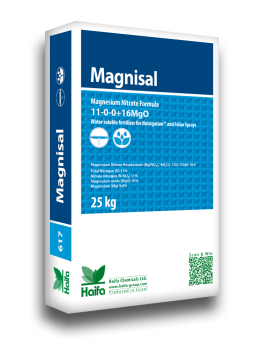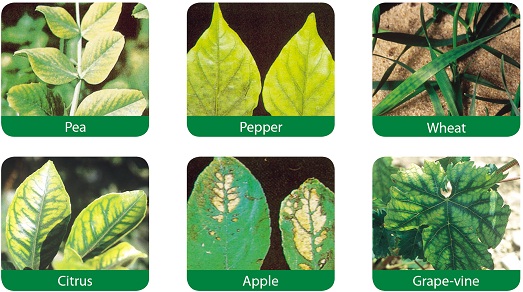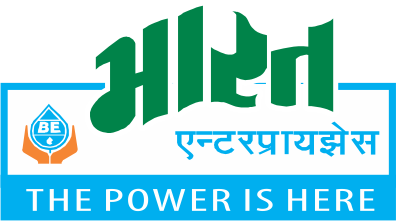Magnisal™ - magnesium nitrate fertilizer for healthy crops

Magnisal™ / Haifa MAG™ magnesium nitrate fertilizer provides plants with readily-available magnesium, which is essential for their healthy growth
The nitrate in Magnisal™ facilitates the uptake of magnesium by the plant, thus improving its efficiency. It also enriches plant nutrition with readily available, easily absorbed ni
Magnesium is essential for the plant
Magnesium is a vital nutrient for healthy plant growth. It is a key component of the chlorophyll molecule, hence essential for photosynthesis and formation of carbohydrates. Magnesium is involved in enzymatic reactions and assists in generation of energy. Magnesium deficiency retards plants development, resulting in decreased yields and poor quality.
Deficiency symptoms
Magnesium deficiency is manifested by yellow bands between leaf veins. The symptoms show first on older leaves, and move towards young leaves as deficiency worsens. In severe cases, necrosis may appear.
Magnesium deficiency in plants

The benefits of Magnisal™ – magnesium nitrate fertilizer
- Prevents and cures magnesium deficiencies
- Consists of 100% plants nutrients
- Free of chloride, sodium and other detrimental elements
- Dissolves quickly and completely in water
- Ideal for efficient applications by fertigation and foliar spray
Magnisal™ is a superior source of magnesium
Magnesium nitrate is superior to magnesium sulfate fertilizers. It possesses higher nutritional value and better physical properties that make it more convenient for handling and application.
Plant nutritional value
Plants absorb the magnesium from Magnisal™ more readily, due to the interaction between the magnesium and the nitrate anion. Magnisal™ is up to three-fold more effective than magnesium sulfate in preventing and curing magnesium deficiencies, and therefor enables considerably lower
application rates.
Magnisal™ magnesium nitrate formula
Product analysis
| Total nitrogen (N) | 11.0% |
| Nitrate-nitrogen (N-NO3) | 11.0% |
| Magnesium oxide (MgO) | 16.0% |
| Magnesium (Mg) | 9.6% |
| Insoluble matter | 200 ppm |
| Bulk density | 0.7 g/cm³ 0.4 Oz/In.³ |
Water solubility
Magnisal™ is extremely soluble in water. It dissolves quickly and does not form precipitate, even at low temperatures.
| Water temperature (°C) | 0 | 10 | 20 | 30 | 40 |
| Grams Magnisal /liter | 1730 | 2000 | 2250 | 2560 | 2890 |
| Water temperature (°F) | 32 | 50 | 68 | 86 | 104 |
| Lbs Magnisal/gallon | 14.4 | 16.7 | 18.8 | 21.4 | 24.1 |
pH and EC
Magnisal™ is slightly acidic, which improves its absorption by leaf surface when sprayed, and enables tank-mixing with chelated nutrients and pesticides. The electrical conductivity (EC) of Magnisal™ solution is low, compared to other fertilizers.
| Concentration (%) | Lbs/100 gal | pH | EC (mS/cm) |
|---|---|---|---|
| 0.1 | 1.2 | 5.6 | 0.88 |
| 0.2 | 2.2 | 5.5 | 1.69 |
| 0.3 | 3.6 | 5.4 | 2.52 |
| 1.0 | 12 | 4.8 | 7.58 |
| 5.0 | 60 | 4.1 | 29.9 |
Physical and chemical properties
Magnisal™ is fully soluble in water. It is approximately ten-fold more soluble than Magnesium Sulfate:
| Magnisal | Magnesium sulfate (Epsom Salt) | |
|---|---|---|
| Solubility at 20°C | 2250 g/l | 252 g/l |
| 68°F | 18.8 lbs/gal | 2.1 lbs/gal |
| Insoluble matter | 300 ppm | 3000-5000 ppm |
| Compatibility with calcium fertilizers | Compatible | Incompatible |
Nutrigation™ with Magnisal™
Nutrigation™ (fertigation), delivery of pure plant nutrients through the irrigation system, is a highly efficient application method, enabling full control over rates, composition, timing and placement of plant nutrition.
Magnisal™ is ideal for Nutrigation™ of crops in both soil and soilless media. Pure and highly soluble, Magnisal™ is safe for use with all types of irrigation equipment. It is compatible with all water-soluble fertilizers, except concentrated phosphate solutions.
Magnisal™, unlike magnesium sulfate, can be used with water of poor quality, hence recommended when the irrigtion water contains high levels of sulfates or salts. In most irrigation practices, magnesium concentration in the water should range between 20-60 ppm.
The following table shows stock-solution levels and injection ratios needed to obtain specified magnesium concentrations in the irrigation water.
| Mg concentration in the irrigation water | ||||||
|---|---|---|---|---|---|---|
| 20 ppm | 40 ppm | 60 ppm | 80 ppm | 100 ppm | ||
| Stock solution | Injection ratio | |||||
| 25 kg / 1000 liter | 8.3 | 16.7 | 25.0 | 33.3 | 41.7 | Liter/m³ |
| 50 kg / 1000 liter | 4.2 | 8.4 | 12.5 | 16.8 | 21 | |
| 50 Lbs / 200 gallon | 1.0 | 2.0 | 3.0 | 4.0 | 5.0 | Oz. /gallon |
| 100 Lbs / 200 gallon | 0.5 | 1.0 | 1.5 | 2.0 | 2.5 | |
When the injection ratio is preset, change the concentration of the stock solution to determine the concentration in the irrigation water (ppm Mg):
| Target concentration | 20 ppm | 40 ppm | 60 ppm | 80 ppm | ||||
|---|---|---|---|---|---|---|---|---|
| Injection ratio | kg/l | Oz/gal | kg/l | Oz/gal | kg/l | Oz/gal | kg/l | Oz/gal |
| 1:16 | 3.3 | 0.45 | 6.6 | 0.89 | 10.0 | 1.34 | 13.3 | 1.78 |
| 1:100 | 20.8 | 2.78 | 41.5 | 5.56 | 62.3 | 8.35 | 83.0 | 11.13 |
| 1:128 | 26.6 | 3.56 | 53.1 | 7.12 | 79.7 | 10.68 | 106.3 | 14.24 |
| 1:150 | 31.1 | 4.17 | 62.3 | 8.35 | 93.4 | 12.52 | 124.5 | 16.69 |
| 1:200 | 41.5 | 5.56 | 83.0 | 11.13 | 124.5 | 16.69 | 166.0 | 22.25 |
Note: data refer to magnesium (Mg) levels in the irrigation water, not to magnesium oxide (MgO).
Nutrigation™ of soil-grown crops
Determine Mg requirements according to soil and water analyses. If additional magnesium is required, apply 0.1-0.3 grams Magnisal™ per liter of irrigation water (1.3-4 Oz./100 gallon) per application.
Nutrigation™ in soilless media
For most crops, recommended magnesium concentration in the nutrient solution is 50-70 ppm MgO (30-40 ppm Mg). The magnesium level in the irrigation water should be taken into account. When the
Two-Tank method is employed, dissolve Magnisal™ in the tank that does not contain phosphorus (P).
The given recommendations should be regarded as a general guide only.
The exact fertilization program should be determined according to the specific crop needs, soil and water conditions, and the grower’s experience. For best results, follow the recommendation of a local crop consultant.
Magnisal™ for foliar applications
Foliar spray is an efficient tool to supplement and to enrich plant nutrition.
When absorption of nutrients from the soil is disturbed, foliar application of Magnisal™ provides the magnesium needed for normal development of crops.
When prompt correction of magnesium deficiency is required, foliar application is recommended, as uptake of magnesium by the leaves is very fast.
Preparation of tank-mix
Dissolve Magnisal™ in a small amount of water and add to the spray tank. When applying with cropprotecting agents, addition of wetting agent is not necessary. To ensure compatibility of tank-mix components, perform a small-scale test prior to actual application.
Foliar spray
To verify safety of suggested rates under local conditions and for specific varieties, it is recommended to spray on a few branches or plants. After 3-4 days check the tested plot for scorching symptoms.
| Crop | When to apply | Spray concentration (%) | Lbs. Magnisal™/ 100 gal water |
|---|---|---|---|
| Citrus | 1- 4 applications, when spring flush leaves are about 2/3 of final size and not yet hardened | 1-1.5 | 8-12 |
| Deciduous fruit- trees | 3-4 applications at 14-day intervals, starting at bloom | 0.5-1.5 | 4-12 |
| Grapes | To prevent “Dry Stalk”: 1-3 applications at 10-day intervals, starting after bunches have formed | 0.5-1 | 4-8 |
| To prevent and cure chlorosis: 1-3 applications at 10-day intervals, starting after berry setting | 0.5-1 | 4-8 | |
| Mango | 1-2 applications when young leaves are about 2/3 of final size | 0.5-1 | 4-8 |
| Olive | • One week before anthesis • Three weeks after bloom | 0.5 | 6-12 |
| Potato | 3 applications at 2, 3 & 4 weeks after emergence | 0.7-1.5 | 4-12 |
| Tomato | At the beginning of fruiting | 0.5-1.5 | 4-12 |
| Cucumber | At the beginning of fruiting | 0.5 | 4 |
| Barley | Beginning of shooting | 0.5-4 | 4-30 |
| Winter wheat | • Beginning of stem elongation • Node formation • Flag leaf sheet opening • Anthesis complete | 0.5 | 4 |
The given recommendations should be regarded as a general guide only.
The exact fertilization program should be determined according to the specific crop needs, soil and water conditions, and the grower’s experience. For best results, follow the recommendation of a local crop consultant.
